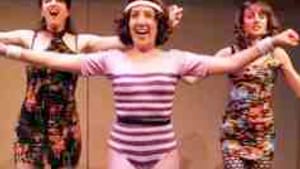Stay in the Loop
BSR publishes on a weekly schedule, with an email newsletter every Wednesday and Thursday morning. There’s no paywall, and subscribing is always free.
Less than meets the eye
"That Pretty Pretty: Or, the Rape Play,' by Theatre Exile

Written jointly with Gresham Riley
That Pretty Pretty: Or, the Rape Play, isn’t a play; it’s a play about writing a play. This fact is made clear by the closing scene, in which the actor-playwright appears on a bare stage in a talk-back session with an imaginary audience, supposedly answering questions about what we (the real audience) have just seen.
The self-referential structure of That Pretty Pretty, along with its paucity of plot and character development, makes clear that we are in post-modernist land. Numerous “big ideas” make their appearance: the blurring of gender differences in the modern era; the brutality of men toward women and vice versa; the fear of commitment; the need to speak truth to power (although no inkling is offered as to what truths are to be spoken); the sins of neo-conservatives; and contemporary society’s proclivity for fouling its own nest (signaled by two scenes in which characters piss on their own beds).
All these ideas are introduced, but they’re never developed into a narrative that makes for a coherent plot. But don’t forget: We’re in post-modernist land.
Saved by the lighting
The cast of Sheila Callaghan’s play consists of two feminist avenging prostitutes (Charlotte Ford and Christie Parker); two male doppelgängers of Agnes and Valerie (Jered McLenigan and Allen Radway); and Jane Fonda/Jane (Amy Smith). (Radway’s character, named Owen, also plays the post-modernist role of playwright.) Each performer gets as much out of and gives as much to each role as is possible— an accomplishment in itself.
Director Joe Canuso, in turn, imposes sufficient structure on the production to make clear that there’s less here than meets the eye. The production’s real creative star is Jorge Cousineau, whose set design, lighting and video sequences provide the magic that we expect from theater at its challenging best.
Seneca said it all
Before undertaking any project, the Roman statesman/philosopher Seneca counseled, we should first take a careful look at ourselves; second, look at the project itself and its merits; and third, look at those for whose sake it’s being undertaken.
Playwright Callaghan must have read her Seneca (especially his second admonition), because in the final talkback scene she has her actor-playwright Owen field questions about the play from an imaginary audience. The last question posed— one not repeated by Owen as was the case with all the others— is left to the real audience’s imagination: What is the play about and is it worth performing? Owen thinks long and hard, projects a skillful array of facial expressions, and finally drops the microphone while exiting the stage. The rest is silence.♦
To read a response, click here.
Sign up for our newsletter
All of the week's new articles, all in one place. Sign up for the free weekly BSR newsletters, and don't miss a conversation.
